Botanical Studies Based on Textual Evidence in Eastern Asia and Its Implications for the Ancient Climate
Abstract
1. Introduction
2. Materials and Methods
2.1. Study Site
2.2. Research Subjects and Temporal Scope
2.3. Taxonomic Study
2.4. Climatic Analysis
2.4.1. Overview of Climatic Reconstruction Methodology
2.4.2. Construction of the Atlas of Woody Plants in China
2.4.3. Procedure for Climate Parameter Extraction
2.4.4. Core Climate Parameter Suite
2.4.5. Methodological Implementation of Paleoclimate Reconstruction
2.5. Statistical Analysis
3. Results
3.1. Results of the Taxonomic Studies
3.2. Climatic Analysis of Woody Plants in the Book of Buddhist Temples in Luoyang
4. Discussion
4.1. Plant Species in Ancient Luoyang City
4.2. Climatic Type of Ancient and Modern Luoyang
4.3. Climate Change over Long Timescales
5. Conclusions
Supplementary Materials
Author Contributions
Funding
Institutional Review Board Statement
Informed Consent Statement
Data Availability Statement
Acknowledgments
Conflicts of Interest
References
- Oliver, J.E. aL-Biruni’s chronology: A source for historical climatology. Clim. Change 1991, 18, 437–452. [Google Scholar] [CrossRef]
- Nash, D.J.; Adamson, G.C.D. Recent advances in the historical climatology of the tropics and subtropics. Bull. Am. Meteorol. Soc. 2014, 95, 131–146. [Google Scholar] [CrossRef]
- Zhang, H.; Werner, J.P.; Garcia-Bustamente, E.; Gonzalez-Rouco, F.; Wagner, S.; Zorita, E.; Fraedrich, K.; Jungclaus, J.H.; Ljungqvist, F.C.; Zhu, X.H.; et al. East Asian warm season temperature variations over the past two millennia. Sci. Rep. 2018, 8, 7702. [Google Scholar] [CrossRef]
- Heimburger, B.; Maurer, S.S.; Schardt, L.; Scheu, S.; Hartke, T.R. Historical and future climate change fosters expansion of Australian harvester termites, Drepanotermes. Evolution 2022, 76, 2145–2161. [Google Scholar] [CrossRef] [PubMed]
- Wang, L.; Zhang, D., II. Progress of overseas research on climate change in the last two millennia. Meteorol. Sci. Technol. 2001, 29, 21–28. [Google Scholar]
- Briffa, K.R.; Osborn, T.J. Seeing the wood from the trees. Science 1999, 284, 926–927. [Google Scholar] [CrossRef]
- Briffa, K.R.; Osborn, T.J. Blowing hot and cold. Science 2002, 295, 2227–2228. [Google Scholar] [CrossRef]
- Isdale, P.J.; Stewart, B.J.; Tickle, K.S.; Lough, J.M. Paleohydrological variation in a tropical river catchment: A reconstruction using flourescent bands in corals of the Great Barrier Reef, Australia. Holocene 1998, 8, 1–8. [Google Scholar] [CrossRef]
- Evans, M.N.; Kaplan, A.; Cane, M.A. Optimal sites for coral-based reconstruction of global sea surface temperature. Paleoceanography 1998, 13, 502–516. [Google Scholar] [CrossRef]
- Evans, M.N.; Kaplan, A.; Cane, M.A. Pacific Sea surface temperature field reconstruction from coral δ18O data using reduced space objective analysis. Paleoceanography 2002, 17, 1–13. [Google Scholar] [CrossRef]
- Thompson, L.G.; Mosley-Thompson, E.; Davis, M.E.; Lin, P.-N.; Henderson, K.; Mashiotta, T.A. Tropical glacier and ice core evidence of climate change on annual to millennial time scales. Clim. Change 2003, 59, 137–155. [Google Scholar] [CrossRef]
- Lauritzen, S.E.; Lundberg, J. Speleothems and climate: A special issue of the Holocene. Holocene 1999, 9, 643–647. [Google Scholar] [CrossRef]
- Cronin, T.M.; Dwyer, G.S.; Kamiya, T.; Schwede, S.; Willard, D.A. Medieval Warm Period, Little Ice Age and 20th century temperature variability from Chesapeake Bay. Glob. Planet. Change 2003, 36, 17–29. [Google Scholar] [CrossRef]
- Hughen, K.; Overpeck, J.T.; Anderson, R.F. Recent warming in a 500-year palaeotemperature record from varved sediments, Upper Soper Lake, Baffin Island, Canada. Holocene 2000, 10, 9–19. [Google Scholar] [CrossRef]
- Mann, M.E.; Rutherford, S.; Bradley, R.S.; Hughes, M.K.; Keimig, F.T. Optimal surface temperature reconstructions using terrestrial borehole data. J. Geophys. Res. 2003, 108, 1–11. [Google Scholar] [CrossRef]
- Grove, J.M.; Switsur, R. Glacial geological evidence for the Medieval Warm Period. Clim. Change 1994, 26, 143–169. [Google Scholar] [CrossRef]
- Waple, A.M.; Mann, M.E.; Bradley, R.S. Long-term patterns of solar irradiance forcing in model experiments and proxy-based surface temperature reconstructions. Clim. Dyn. 2002, 18, 563–578. [Google Scholar] [CrossRef]
- Bauer, E.; Claussen, M.; Brovkin, V.; Huenerbein, A. Assessing climate forcings of the Earth system for the past millennium. Geophys. Res. Lett. 2003, 30, 1–4. [Google Scholar] [CrossRef]
- Jones, P.D.; Mann, M.P. Climate over past millennia. Rev. Geophys. 2004, 42, 1–42. [Google Scholar] [CrossRef]
- Folland, C.K.; Karl, T.R.; Christy, J.R.; Clarke, R.A.; Gruza, G.V.; Jouzel, J.; Mann, M.E.; Oerlemans, J.; Salinger, M.J.; Wang, S.W. Observed climate variability and change. In Climate Change 2001: The Scientific Basis; Houghton, J.T., Ding, Y.D.J.G., Griggs, D.J., Eds.; Cambridge Univ. Press: New York, NY, USA, 2001; pp. 99–181. [Google Scholar]
- Correge, T.; Quinn, T.; Delcroix, T.; Le Cornec, F.; Recy, J.; Cabioch, G. Little Ice Age Sea surface temperature variability in the southwest tropical Pacific. Geophys. Res. Lett. 2001, 28, 3477–3480. [Google Scholar] [CrossRef]
- Moore, G.W.K.; Holdsworth, G.; Alverson, K. Climate change in the North Pacific region over the past three centuries. Nature 2002, 420, 401–403. [Google Scholar] [CrossRef] [PubMed]
- Nie, X.Y.; Sang, Y.F. The Ancient City of Luoyang and the Han-Wei Dynasty; Zhengzhou Ancient Books Publishing House: Zhengzhou, China, 2019. [Google Scholar]
- Luoyang Working Team, Institute of Archaeology, Chinese Academy of Sciences. Preliminary survey of Luoyang city in Han and Wei Dynasty. Archaeology 1973, 4, 198–208. [Google Scholar]
- Yang, Z.L.; Han, S.P. Archaeological integration of Luoyang: Sui, Tang, Five Dynasty and Song; Beijing Library Press: Beijing, China, 2005. [Google Scholar]
- Yang, Z.L.; Mao, Y.G. Archaeological Integration of Luoyang: Qin, Han, Wei, Jin and North and South Dynasties; Beijing Library Press: Beijing, China, 2007. [Google Scholar]
- Gao, M.Q.; Lu, L.D. Ancient Chinese Names of Plants; Elephant Press: Zhengzhou, China, 2006. [Google Scholar]
- Liu, H.M.; Chang, L.; Xia, X.F.; Wang, L.L.; Han, D.; Zhong, B.; Li, Y.M. Research on the original plants of Scallion and its corresponding plants. Chin. Agric. Sci. Bull. 2015, 31, 47–53. [Google Scholar]
- Liu, H.M.; Zhao, Y.; Xia, X.F.; Li, Y.M. Original plants of Celery and its corresponding plants. Chin. Agric. Sci. Bull. 2016, 32, 199–204. [Google Scholar]
- Liu, H.M.; Xia, X.F.; Li, Y.M.; Wang, L.L. Original Plants of “Algae” and Its Corresponding Plants in Historical Books and Records of China. Chin. Agric. Sci. Bull. 2017, 33, 143–146. [Google Scholar]
- Mosbrugger, V.; Utescher, T. The coexistence approach—A method for quantitative reconstructions of Tertiary terrestrial palaeoclimate data using plant fossils. Palaeogeogr. Palaeoclimatol. Palaeoecol. 1997, 134, 61–86. [Google Scholar] [CrossRef]
- Fang, J.Y.; Wang, Z.H.; Tang, Z.Y. Atlas of Woody Plants in China: Distribution and Climate. Vol I, II, III, Index; Higher Education Press: Beijing, China, 2009. [Google Scholar]
- Beijing Meteorological Center Data Office. China’s Surface Climate Data 1971–1980; China Meteorological Press: Beijing, China, 1984. [Google Scholar]
- Wang, Y.F.; Liu, T.; Li, Z.C.; Shangguan, Z.P. Carbon storage and carbon density of forest vegetation in Luoyang, Western Henan Province. Acta Pratacult. Sin. 2015, 24, 1–11. [Google Scholar]
- Xiao, L.; Wang, J.; Ji, D.; Guo, L.; Wang, X.; Liang, J.; Xia, X.; Ren, W.; Li, X. Quantitative Reconstruction of Paleoclimatic Changes in the Late Miocene Eastern Zhejiang Based on Plant Fossils. Atmosphere 2023, 14, 986. [Google Scholar] [CrossRef]
- Gao, M.; Ge, R.; Wang, Y. Spring Meteorological Drought over East Asia and Its Associations with Large-Scale Climate Variations. Water 2024, 16, 1508. [Google Scholar] [CrossRef]
- Zhu, K.Z. Fluctuations of world climate during the historical period. Acta Meteorol. Sin. 1962, 31, 275–287. [Google Scholar]
- Lamb, H.H. Climate: Present, Past and Future: Volume 2: Climate History and the Future; Methuen: London, UK; New York, NY, USA, 1977; pp. 1–835. [Google Scholar]
- Bryson, R.A.; Murray, T.J. Climates of Hunger: Mankind and the World’s Changing Weather; University of Wisconsin Press: Madison, WI, USA, 1977. [Google Scholar]
- Hinsch, B. Climatic change and history in China. J. Asian Hist. 1988, 22, 131–159. [Google Scholar]
- Wang, H.C. The relationship between the migrating south of the nomadic nationalities in north China and the climatic changes. Sci. Geo. Sin. 1996, 16, 274–279. [Google Scholar]
- Wu, L.H. The impact of climate change on ancient Chinese agriculture in historical period. Chin. Agric. Inform. 2014, 9, 175–176. [Google Scholar]
- Ge, Q.S. Climate Change in Chinese Dynastic History; Beijing Science Press: Beijing, China, 2010. [Google Scholar]
- Zhu, K.Z. A preliminary study on climatic variations in China over the past five thousand years. Sci. Sin. 1973, 16, 475–498. [Google Scholar]
- Brooks, C.E.P. Climate Through the Age; Dover Publications: London, UK, 1950. [Google Scholar]
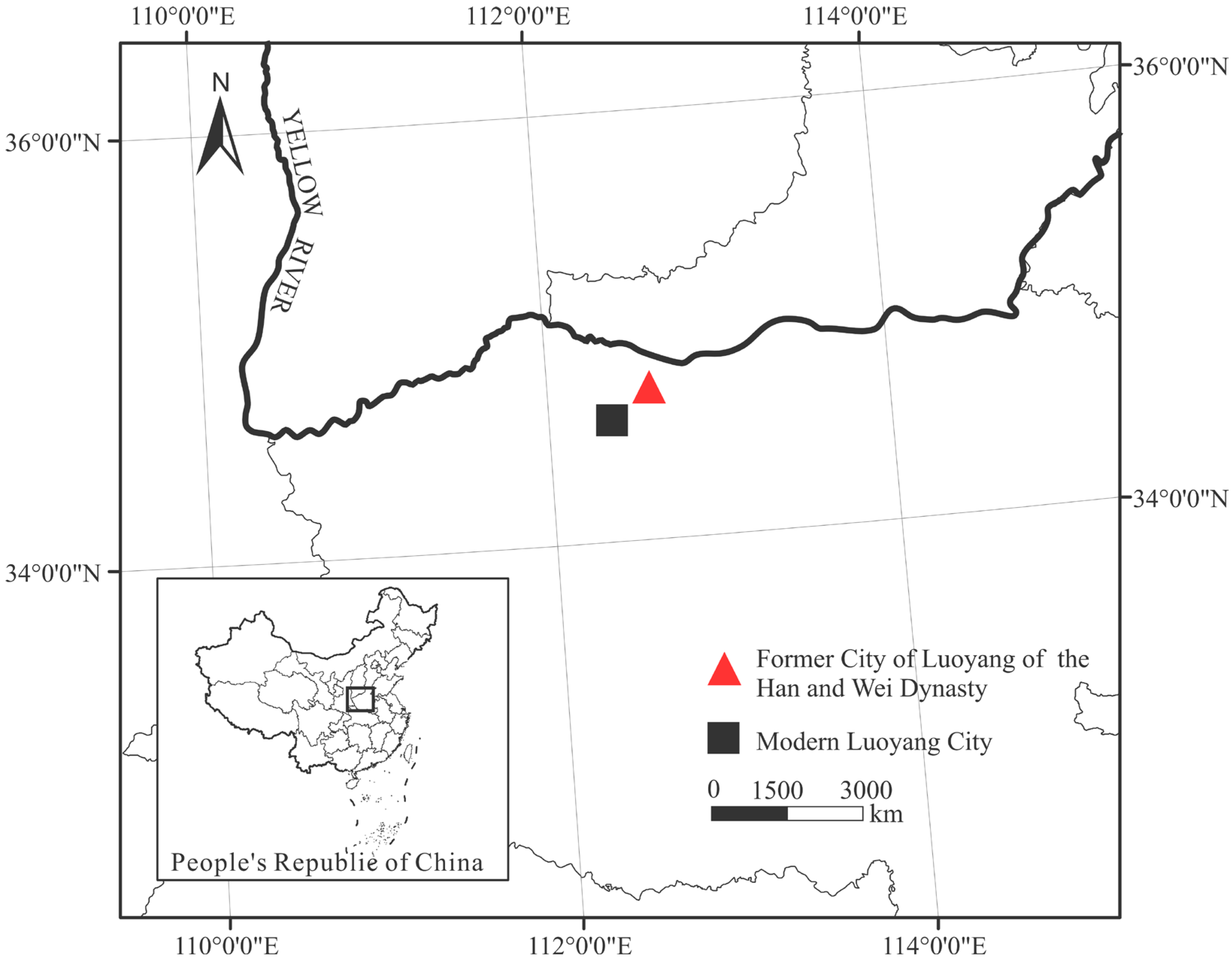
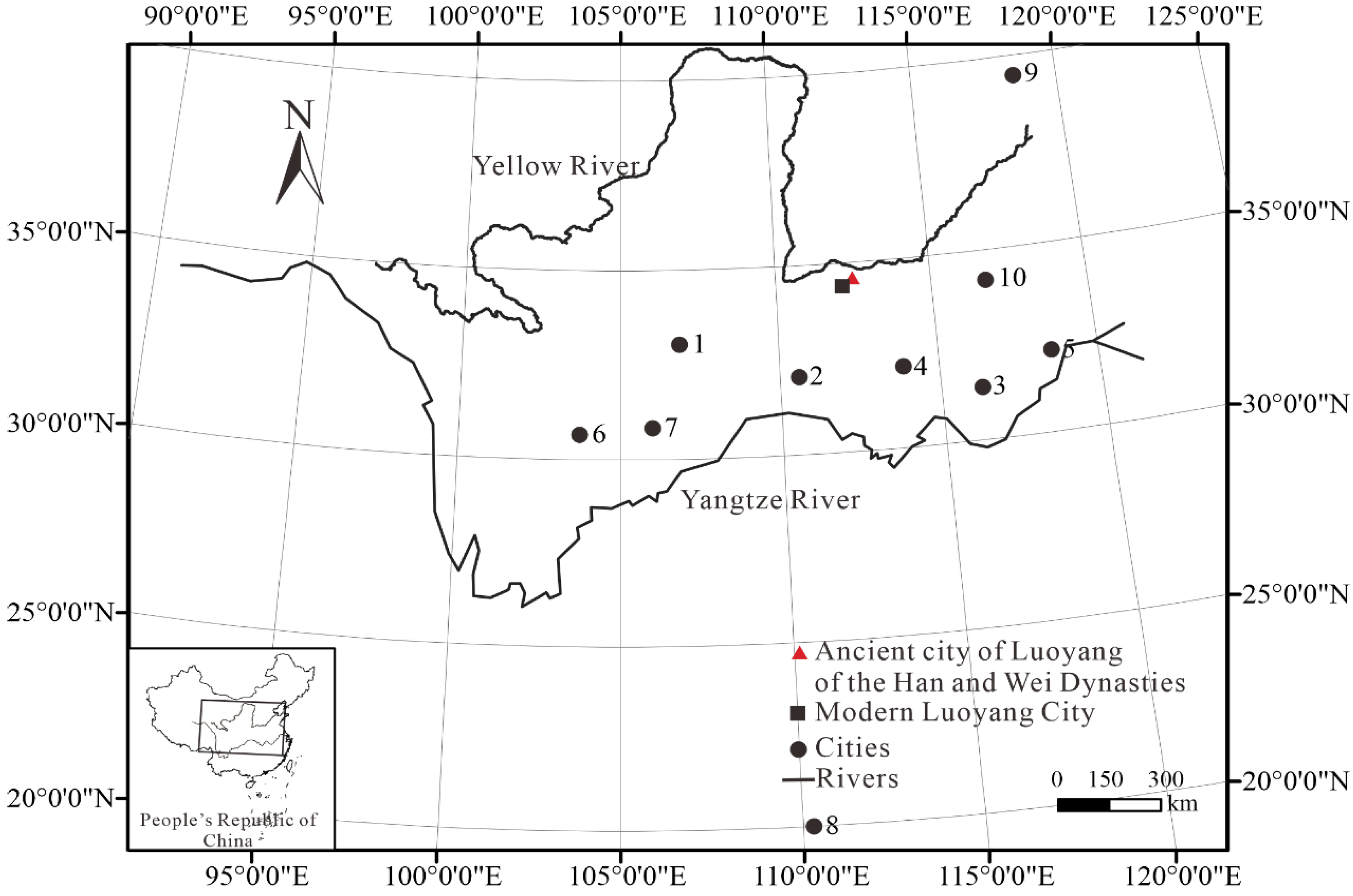
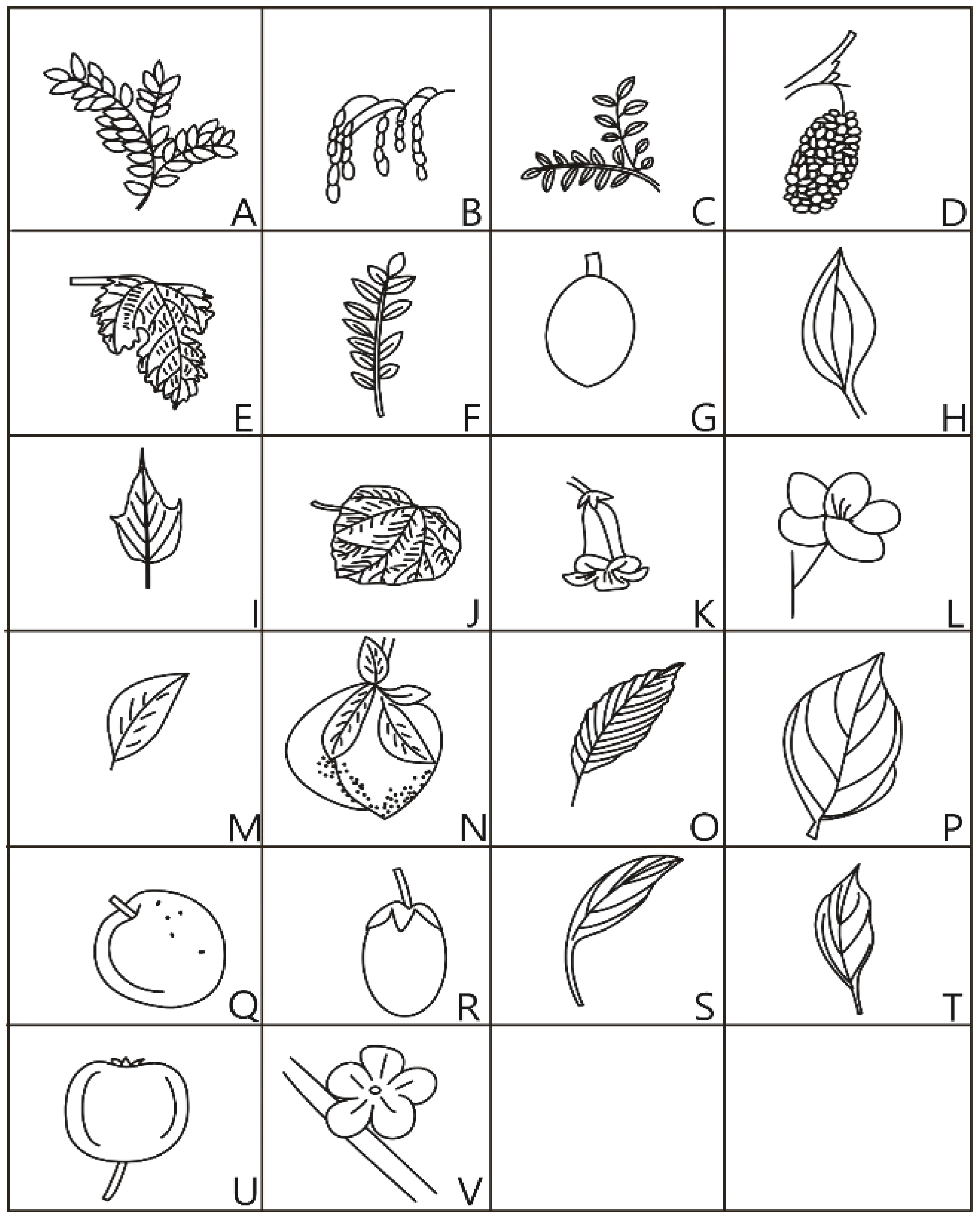
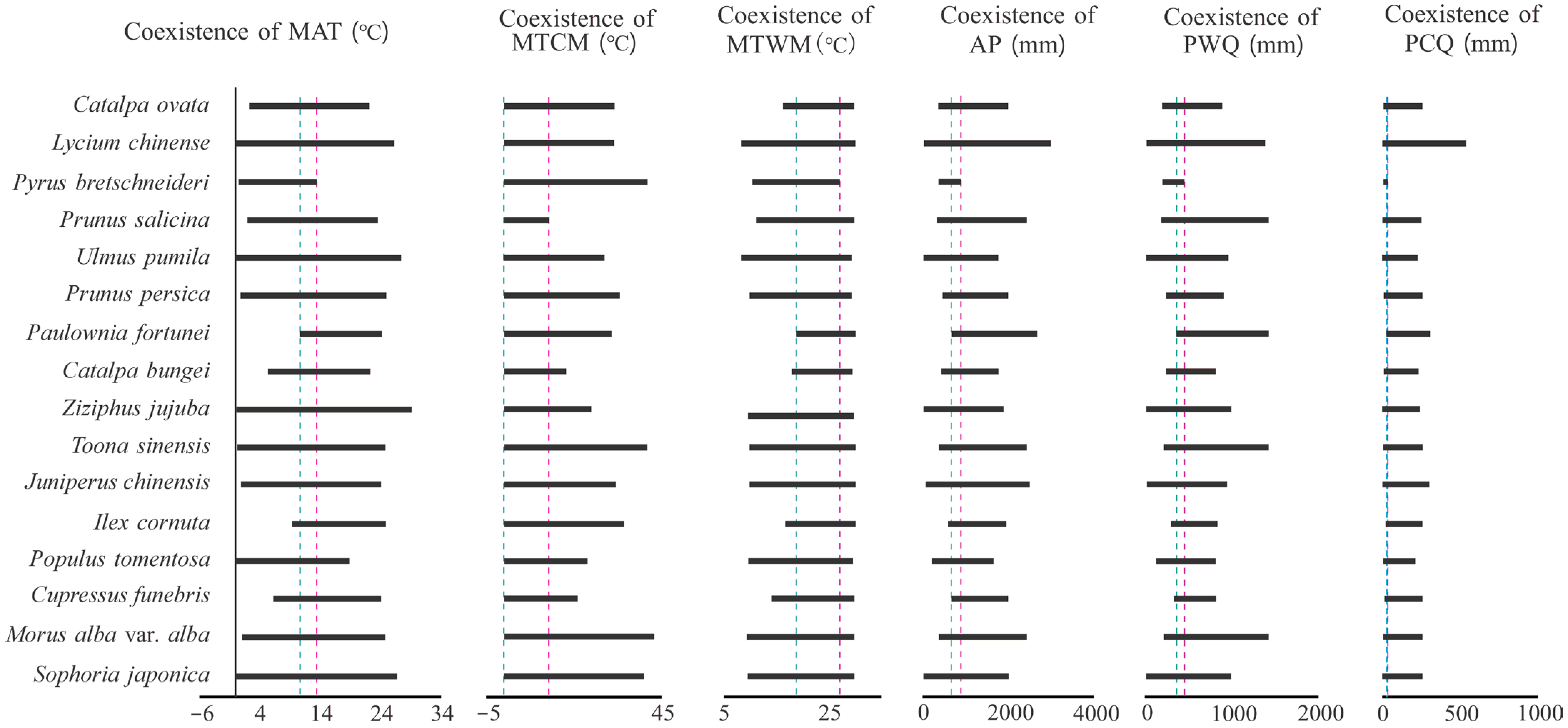
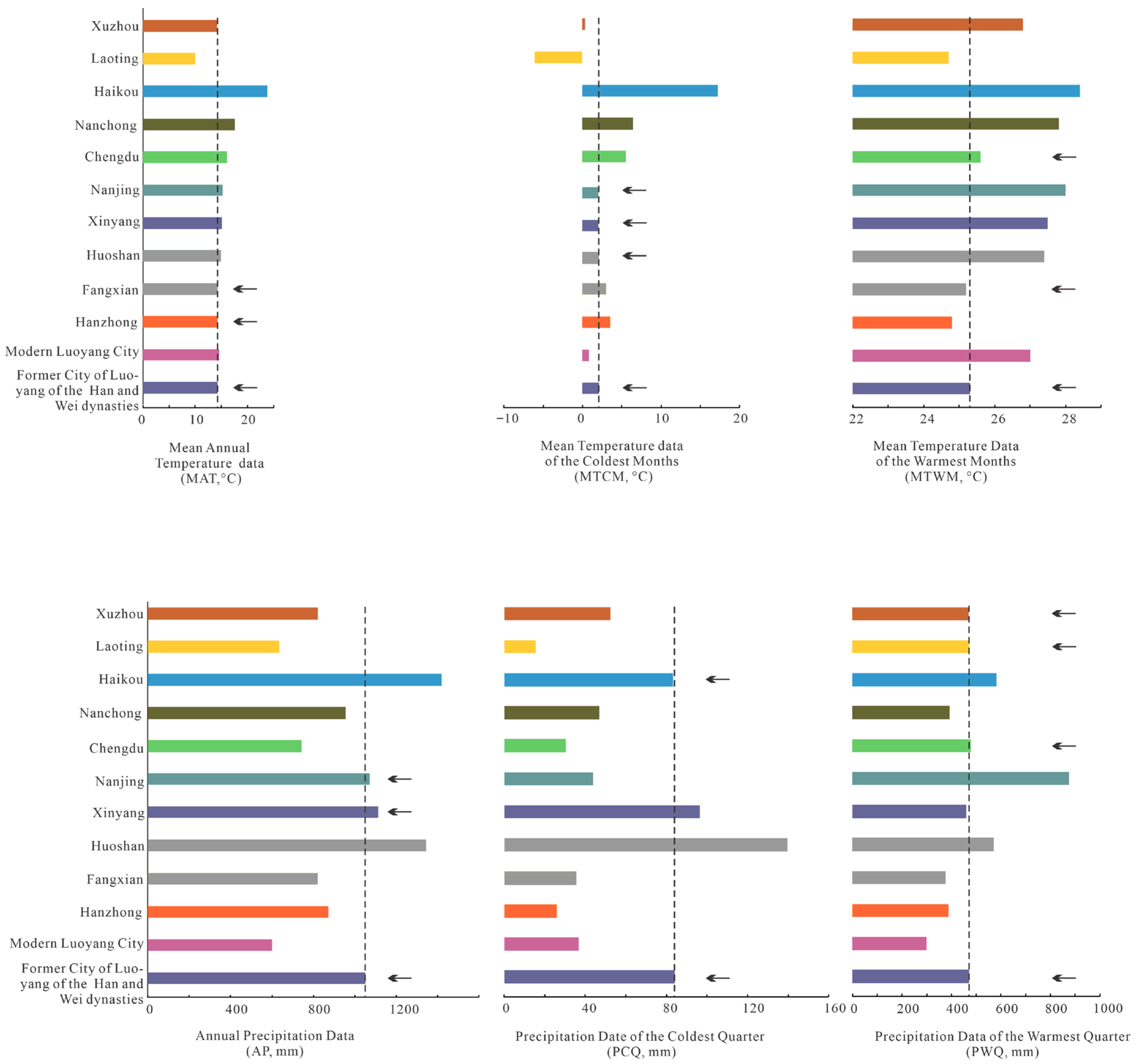
| Ancient Names of Plants | Scientific Names for the Plants |
|---|---|
| Song | Pinus sp. |
| Huai | Styphnolobium japonicum (L.) Schott |
| Sang | Morus alba var. alba Linn. |
| Bai | Cupressus funebris Endl |
| Cheng | Tamarix sp./Myricaria sp. |
| Zhi | Hovenia acerba/Citrus trifoliata |
| Yang | Populus tomentosa Carr. |
| Niu Jin Shu/Beef Tendon Tree | Vaccinium bracteatum Thunb. |
| Gou Gu/Dogwood | Ilex cornuta Lindl. et Paxt. |
| Jiu Shu/Liquor Tree | Cocos nucifera L. |
| Mian Mu/Flour Wood | Arenga westerhoutii Griffith |
| Gua | Juniperus chinensis L. |
| Chun | Toona sinensis (A. Juss.) Roem. |
| Zao | Ziziphus jujuba Mill |
| Qiu | Catalpa bungei C.A. Mey. |
| Tong / Tung | Paulownia fortunei (Seem.) Hemsl. |
| Tao | Prunus persica L. |
| Yu | Ulmus pumila L. |
| Li (01) | Prunus salicina Lindl. |
| Nai | Malus pumila Mill. |
| Li(02) | Pyrus bretschneideri Rehd. |
| Qi | Lycium chinense Miller |
| Zi | Catalpa ovata G. Don |
Disclaimer/Publisher’s Note: The statements, opinions and data contained in all publications are solely those of the individual author(s) and contributor(s) and not of MDPI and/or the editor(s). MDPI and/or the editor(s) disclaim responsibility for any injury to people or property resulting from any ideas, methods, instructions or products referred to in the content. |
© 2025 by the authors. Licensee MDPI, Basel, Switzerland. This article is an open access article distributed under the terms and conditions of the Creative Commons Attribution (CC BY) license (https://creativecommons.org/licenses/by/4.0/).
Share and Cite
Liu, H.; Song, H.; Duan, F.; Shen, L. Botanical Studies Based on Textual Evidence in Eastern Asia and Its Implications for the Ancient Climate. Atmosphere 2025, 16, 824. https://doi.org/10.3390/atmos16070824
Liu H, Song H, Duan F, Shen L. Botanical Studies Based on Textual Evidence in Eastern Asia and Its Implications for the Ancient Climate. Atmosphere. 2025; 16(7):824. https://doi.org/10.3390/atmos16070824
Chicago/Turabian StyleLiu, Haiming, Huijia Song, Fei Duan, and Liang Shen. 2025. "Botanical Studies Based on Textual Evidence in Eastern Asia and Its Implications for the Ancient Climate" Atmosphere 16, no. 7: 824. https://doi.org/10.3390/atmos16070824
APA StyleLiu, H., Song, H., Duan, F., & Shen, L. (2025). Botanical Studies Based on Textual Evidence in Eastern Asia and Its Implications for the Ancient Climate. Atmosphere, 16(7), 824. https://doi.org/10.3390/atmos16070824






